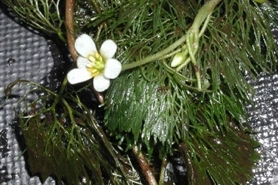Fanwort
(Cabomba caroliniana)
Fanwort is a perennial submersed or sometimes floating aquatic herb. Fanwort is native to the southeastern United States but is easily spread and has created nuisance conditions as far north as New York, Michigan and Oregon.
Other names for this plant include:
- Common names: Carolina fanwort, fish grass, Carolina water-shield
- Scientific names: Cabomba caroliniana var caroliniana; C. australis
Classification in Wisconsin: Prohibited
- Ecological Threat
-
- Forms dense stands in some areas, crowding out other vegetation, clogging streams and drainage canals, and interfering with recreational, agricultural and aesthetic water use.
- Control is difficult, as fragmentation can cause resprouting.
- Identification
-
Leaves: Tightly spaced; submersed leaves have petioles and a tubular appearance, are finely divided, less than 1" long and 2" comprehensive, fan-shaped and arranged in pairs on the stem or whorled; floating leaves (when present) are 0.25-0.75" long, inconspicuous, diamond-shaped with the stem attached in the center and alternate on stems.
Flowers: White with yellow centers; less than 0.5" in diameter; at the end of 1-4" long peduncles; floating; bloom May to September.
Roots: Short rhizomes with fibrous roots.
Similar species: Fanwort looks similar to coon's-tail (Ceratophyllum spp.), milfoils (Myriophyllum spp.), water buttercup (Ranunculus aquatilis), and Beck's water marigold (Megalodonta beckii). The leaves of milfoil species are whorled and the plants have small, axillary flowers. Water buttercup has alternate leaves and Beck's marigold has yellow composite flowers and sessile leaves.
- Distribution
-
Currently, there have been no reports of fanwort in Wisconsin. Have you seen it? Please send us a report.
- Control
-
Mechanical: Water-level drawdowns have reduced growth in some areas in the south, but extreme drying is necessary to prevent regrowth from seed. A venture dredge (like a giant vacuum cleaner) can overcome the problem of fragmentation and reduce populations.
Chemical: Endothall and fluridone may be effective herbicide treatments.
- Resources
- Sources for content:
- Czarapata, Elizabeth; Invasive Plants of the Upper Midwest: an illustrated guide to their identification and control. The University of Wisconsin Press. 2005. Pg. 143
- Global Invasive Species Database: Cabomba caroliniana [exit DNR].
- Invasive Plant Atlas of New England: Cabomba caroliniana [exit DNR]
- Carolina fanwort (Cabomba caroliniana) A Technical Review of Distribution, Ecology, Impacts, and Management [PDF] Wisconsin DNR publication SS-1047



